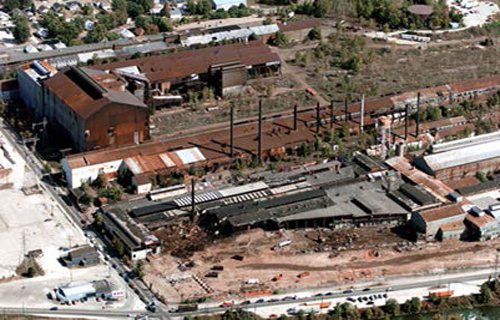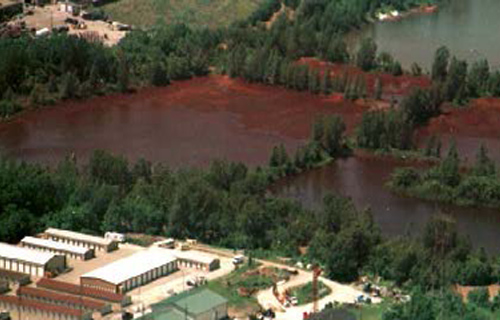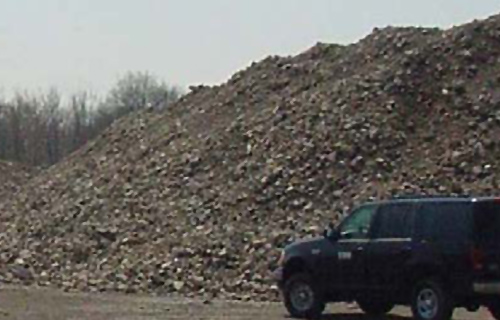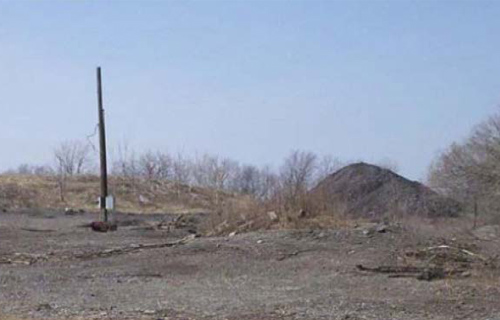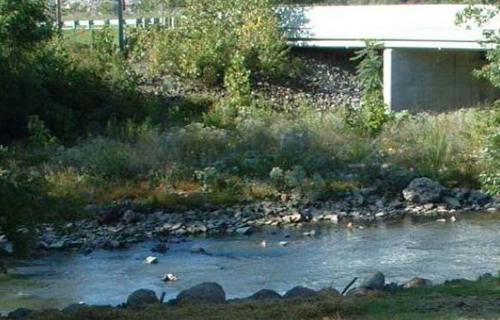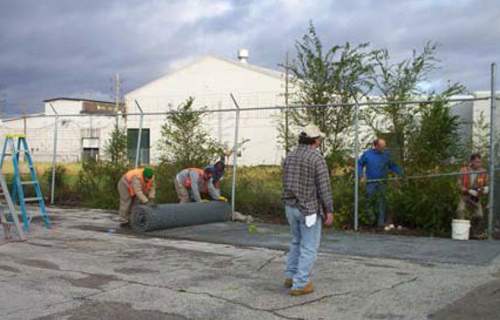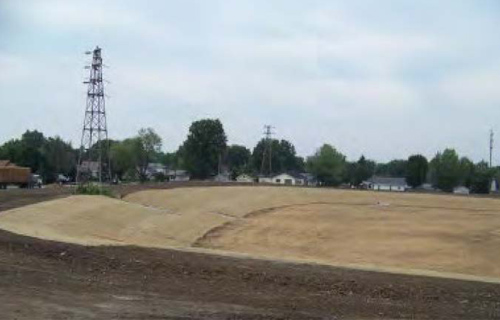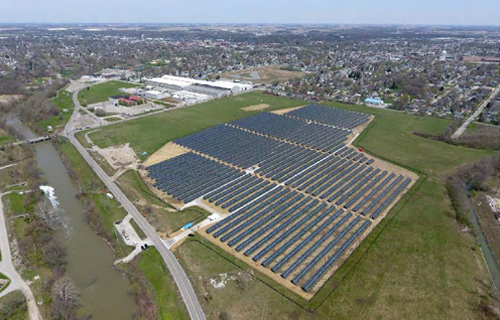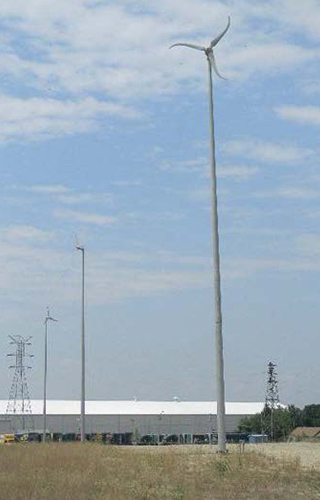Green Remediation Focus
Continental Steel Corp.
Kokomo, Indiana
NPL
Cleanup Objectives: Remediate soil and groundwater contaminated by volatile organic compounds, polychlorinated biphenyls, polynuclear aromatic hydrocarbons and metals such as lead resulting from past use of this 183-acre site for manufacturing steel products. Areas of concern encompassed Kokomo and WildCat Creeks, acid lagoons, a quarry, the main manufacturing plant and a slag processing and disposal area. Source contamination was addressed by dredging, excavating or consolidating contaminated soil and waste material for offsite disposal or by onsite capping, as well as conducting heated soil vapor extraction in targeted areas. An onsite groundwater extraction system has operated since 2011 to treat the groundwater plume and prevent its migration off the site.
Green Remediation Strategy: Reduce the environmental footprint of activities involved in waste removal or capping, land restoration and long-term extraction of contaminated groundwater, with a focus on:
- Using the site's onsite resources to generate renewable energy.
- Optimizing management of stormwater across the site, approximately half of which lies in a 100-year floodplain.
- Maximizing reuse or recycling of demolition and construction waste materials.
- Minimizing import of raw materials and offsite disposal of waste.
Plans for constructing and operating the site remedy were closely integrated with plans for anticipated reuse of the site, which is now owned by the City of Kokomo.
Results:
Renewable Energy Generation and Fuel Conservation
- Offsetting up to 60% of the grid electricity needed to power the groundwater extraction system through operation of three 2.4 (7.2 total) kilowatt (kW) grid-tied wind turbines installed in the former quarry area. The groundwater extraction system utilizes 16 wells from which water is continuously extracted at a rate of up to 266 gallons per minute (gpm). Through remotely controlled operations, the extracted groundwater is directed to the Kokomo wastewater treatment plant located adjacent to the site.
- Using onsite solar energy to intermittently pump contaminated groundwater and fuel oil that accumulates in a concrete-lined sump along an onsite stream, at the location of past storage tanks. The solar system consists of a 75 watt photovoltaic (PV) panel that powers an extraction pump capable of withdrawing up to 25 gpm of liquid during daylight hours.
- Producing about 9.1 million kilowatt-hours of solar energy a year, which is enough to power 1,000 typical homes, through operation of a 7.2 megawatt solar farm constructed in 2016 in the vicinity of the site's former main plant. The solar farm consists of approximately 21,000 PV panels and supporting infrastructure positioned across 26 acres where contaminated material had been covered with an 18-inch-thick soil cap. Through a 20-year power purchase agreement, Alterra Power Corp manages the project, Inovateus Solar LLC constructed and maintains the solar farm under a lease with the City of Kokomo, and Duke Energy Indiana purchases and distributes 100% of the generated electricity. The City receives a $36,000 revenue from the lease each year.
- Reduced the amount of diesel fuel and associated air emissions involved in transporting waste and importing raw materials by repurposing onsite materials and infrastructure. Use of the site's unprocessed slag as backfill, for example, avoided 3,300 truck trips otherwise needed to transport the site's slag waste to an offsite disposal facility. Similarly, reuse of the site's quarry pond to store community water avoided 3,000 truck trips otherwise needed to backfill the pond after dredging of the contaminated pond was complete.
Water Quality Preservation and Conservation
- Minimized the potential for stormwater runoff and associated erosion during excavation and backfilling at the 87-acre main plant area, which predominantly slopes toward one of the two creeks bordering the area. Chipped wood from onsite trees requiring removal was used to construct berms in vulnerable areas and to buffer site roads or augment other erosion controls. Additionally, salvaged field stone was placed along the sides of both creeks to armor their banks.
- Providing community capacity to store up to 58,000 cubic yards (cy) of stormwater, by integrating plans for remediating the former quarry pond with City plans for constructing a new stormwater retention pond. The remedial design was revised to specify backfilling of the 4-acre pond to levels 8 to 10 feet less than the surrounding grade, thereby creating a basin. Simultaneously, the City began designing and installing new water lines that direct stormwater from adjacent neighborhoods to the basin instead of the City's combined sewer system. The basin also stores water accumulating in onsite areas, including parcels undergoing redevelopment. Infiltration of stormwater accumulating in the pond vicinity, which experienced two 100-year floods over the past two decades, is fostered by prairie grasses, native plants and trees planted by the City.
Material Recycling or Reuse and Waste Reduction
- Stockpiled 3,500 cy of lead-contaminated soil excavated from the nine-acre slag processing area for later use as industrial fill during site redevelopment, which reduced burdens on the local landfill.
- Used approximately 60,000 cy of unprocessed slag as backfill in the acid lagoon surface impoundments. The U.S. Environmental Protection Agency (U.S. EPA) and Indiana Department of Environmental Management (IDEM) selected this approach as an alternative to the original plan to cover the slag in place, which would have created a mounded area with limited reuse options.
- Reduced the amount of material needed to backfill the former 4-acre quarry pond by approximately 58,000 cy due to reuse of the acreage for the new municipal stormwater retention basin. Other efficiencies in backfilling the former pond, which reached a depth of 70 feet, were gained through coordination of site cleanup with other local projects. For example, approximately 295,440 cy of soil from an offsite area undergoing excavation for use as a second municipal stormwater retention basin was transported directly to the quarry pond. This approach avoided double-handling of the soil, reduced the soil hauling distance to approximately five miles round-trip, and saved the U.S. EPA approximately $5 million.
- Salvaged and stockpiled large field stones included in more than 440,000 tons of clean soil required to fully grade and cover ground surfaces at the main plant area. The stone was later used to stabilize banks of the two creeks bordering the site.
- Salvaged materials during demolition of 125 buildings and other structures for onsite use as fill material, including approximately 4,500 cy of clean brick to fill former basements and other subsurface voids, 21,000 cy of crushed concrete for infill surfacing, and 25,000 cy of concrete rubble to fill low spots in the 87-acre main plant area.
- Salvaged, sorted and recycled steel scrap across the site, including I-beams and other framing or structural supports, tanks, piping, rebar, empty drums, train rails, wire coils and air stacks. Sale of the scrap to local metal recyclers derived a $1.6 million income used to defray remediation costs.
- Identified offsite users for approximately 95% of chain link fencing no longer needed after backfilling and soil cover construction at the main plant area, which included 9,700 linear feet of 8-foot fencing and 574 linear feet of 4-foot fencing. Approximately 75% of the 8-foot fencing was removed by volunteers and reused in a local Rails to Trails project. A local buyer purchased the 4-foot fencing and accompanying posts after IDEM advertised the material availability in the Indiana Materials Exchange.
- Salvaged truck scales that were temporarily used during demolition activities, for sale and beneficial reuse by a regional solid waste management district. The $6,000 sale proceeds were placed in the cleanup project's dedicated fund.
Property End Use: Recreational, retail and warehouse facilities and municipal stormwater/wastewater infrastructure.
Point of Contact: Nabil Fayoumi, U.S. EPA Region 5
To learn about the site's redevelopment partnership, view: https://www.epa.gov/superfund-redevelopment-initiative/superfund-redevelopment-videos#kokomo.
Update: November 2019


